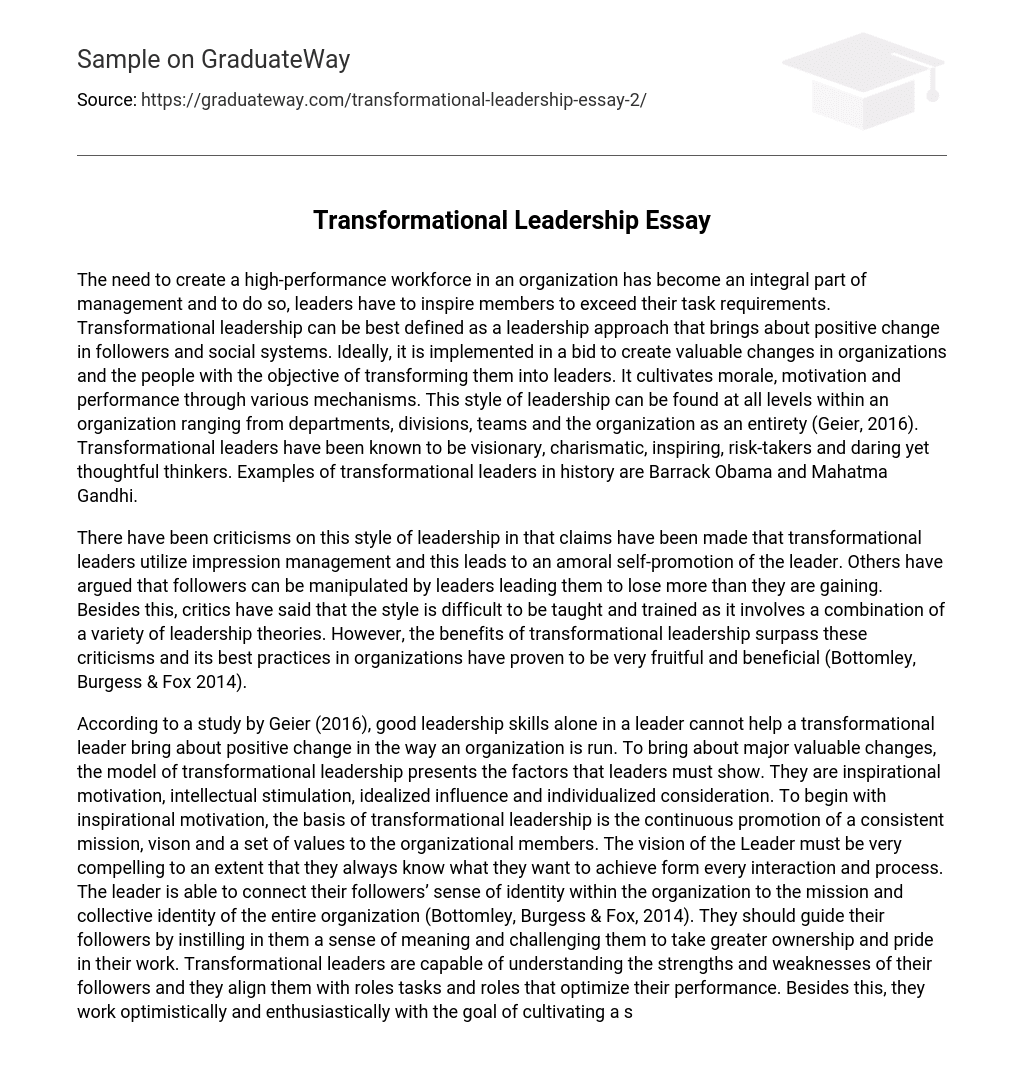The need to create a high-performance workforce in an organization has become an integral part of management and to do so, leaders have to inspire members to exceed their task requirements. Transformational leadership can be best defined as a leadership approach that brings about positive change in followers and social systems. Ideally, it is implemented in a bid to create valuable changes in organizations and the people with the objective of transforming them into leaders. It cultivates morale, motivation and performance through various mechanisms. This style of leadership can be found at all levels within an organization ranging from departments, divisions, teams and the organization as an entirety (Geier, 2016). Transformational leaders have been known to be visionary, charismatic, inspiring, risk-takers and daring yet thoughtful thinkers. Examples of transformational leaders in history are Barrack Obama and Mahatma Gandhi.
There have been criticisms on this style of leadership in that claims have been made that transformational leaders utilize impression management and this leads to an amoral self-promotion of the leader. Others have argued that followers can be manipulated by leaders leading them to lose more than they are gaining. Besides this, critics have said that the style is difficult to be taught and trained as it involves a combination of a variety of leadership theories. However, the benefits of transformational leadership surpass these criticisms and its best practices in organizations have proven to be very fruitful and beneficial (Bottomley, Burgess & Fox 2014).
According to a study by Geier (2016), good leadership skills alone in a leader cannot help a transformational leader bring about positive change in the way an organization is run. To bring about major valuable changes, the model of transformational leadership presents the factors that leaders must show. They are inspirational motivation, intellectual stimulation, idealized influence and individualized consideration. To begin with inspirational motivation, the basis of transformational leadership is the continuous promotion of a consistent mission, vison and a set of values to the organizational members. The vision of the Leader must be very compelling to an extent that they always know what they want to achieve form every interaction and process. The leader is able to connect their followers’ sense of identity within the organization to the mission and collective identity of the entire organization (Bottomley, Burgess & Fox, 2014). They should guide their followers by instilling in them a sense of meaning and challenging them to take greater ownership and pride in their work. Transformational leaders are capable of understanding the strengths and weaknesses of their followers and they align them with roles tasks and roles that optimize their performance. Besides this, they work optimistically and enthusiastically with the goal of cultivating a spirit of commitment and teamwork.
Intellectual stimulation refers to the ability of the leader to steer their followers towards creativity and innovation. In their research findings, Mittal & Dhar (2015) noted that such leaders openly encourage and welcome new ideas and never criticize them publicly in a bid to humiliate them for mistakes they could have made. They do not engage in blame-games but rather, focus on what the problem really is and how it can be solved. Is an old procedure or practice in the organization is found to be ineffective, they have no hesitation to discard it. Further, they have an idealized influence whereby they believe that a successful leader is one who influences their followers by practicing what they advocate for. They are role models and their followers always seek to emulate them. Such a leader is able to win the respect and trust of their followers through their positive influence. They are able to always place the needs pf their followers and those of the organization above theirs and demonstrate the highest levels of ethical conduct. Transformational leaders use their power and authority to influence the subordinates to work towards the common objectives of the organization.
Lastly, transformational leadership is about individualized consideration whereby the leader always acts as a mentor to the rest and rewards them for outstanding performance, innovation and creativity (Mittal & Dhar, 2015). Followers are treated according to their knowledge, skills and talent. Transformational leaders empower followers by allowing them to make decisions that relate to their work processes and are always ready to provide any necessary support to implement those decisions.
We live in a world whose environment is characterized by organizational instability, global turbulence and uncertainty. Having transformational leadership implemented at all the levels of the organization has a positive implication. The followers behind transformational leaders demonstrate very high levels of organizational commitment, job satisfaction and involve themselves in organizational citizenship behaviors. Such a devoted workforce translates into a highly performing and successful organization (Bottomley, Burgess & Fox, 2014).





